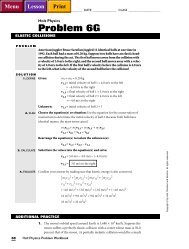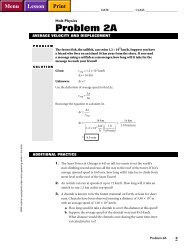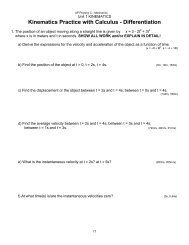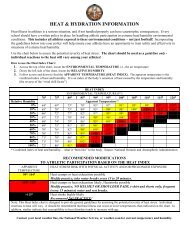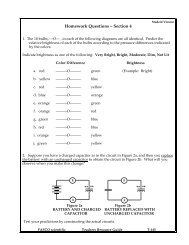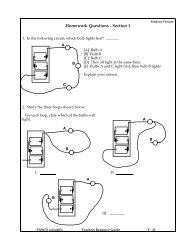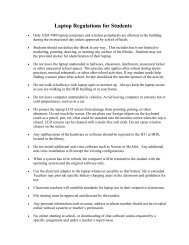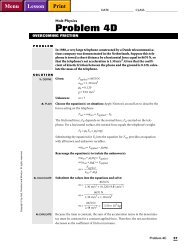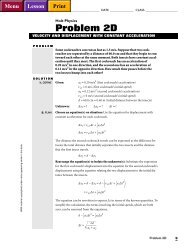Problem 3E - Hays High School
Problem 3E - Hays High School
Problem 3E - Hays High School
- No tags were found...
You also want an ePaper? Increase the reach of your titles
YUMPU automatically turns print PDFs into web optimized ePapers that Google loves.
NAME ______________________________________ DATE _______________ CLASS ____________________Holt Physics<strong>Problem</strong> <strong>3E</strong>PROJECTILES LAUNCHED AT AN ANGLEPROBLEMSOLUTION1. DEFINE2. PLANThe narrowest strait on earth is Seil Sound in Scotland, which lies betweenthe mainland and the island of Seil. The strait is only about 6.0 mwide. Suppose an athlete wanting to jump “over the sea” leaps at an angleof 35° with respect to the horizontal. What is the minimum initial speedthat would allow the athlete to clear the gap? Neglect air resistance.Given:Unknown: v i = ?Diagram:∆x = 6.0 mq = 35°g = 9.81 m/svθ = 35°∆ x= 6.00 mChoose the equation(s) or situation: The horizontal component of the athlete’svelocity, v x , is equal to the initial speed multiplied by the cosine of the angle, q,which is equal to the magnitude of the horizontal displacement, ∆x, divided by thetime interval required for the complete jump.v x = v i cos q = ⎯ ∆ ⎯x∆tAt the midpoint of the jump, the vertical component of the athlete’s velocity, v y ,which is the upward vertical component of the initial velocity, v i sin q, minus thedownward component of velocity due to free-fall acceleration, equals zero. Thetime required for this to occur is half the time necessary for the total jump.v y = v i sin q − g ⎯ ∆ t⎯2 = 0v i sin q = ⎯ g ∆t⎯2Rearrange the equation(s) to isolate the unknown(s): Express ∆t in the secondequation in terms of the displacement and velocity component in the first equation.gv i sin q = ⎯ 2 ⎯∆x⎯⎯ vi cos q 2 g∆xv i = ⎯2sin ⎯q cos qCopyright © by Holt, Rinehart and Winston. Allrights reserved.24Holt Physics <strong>Problem</strong> Workbook
NAME ______________________________________ DATE _______________ CLASS ____________________3. CALCULATE4. EVALUATEv i = ⎯ 2 sig∆ n ⎯ q x c o s qSubstitute the values into the equation(s) and solve: Select the positive root for v i . 9.81⎯m s 2⎯ (6.0 m)= v i ⎯⎯⎯ =(2)(sin 35°)(cos 35°)7.9 ⎯ m s ⎯By substituting the value for v i into the original equations, you can determine thetime for the jump to be completed, which is 0.92 s. From this, the height of thejump is found to equal 1.0 m.ADDITIONAL PRACTICE1. In 1993, Wayne Brian threw a spear a record distance of 201.24 m. (Thisis not an official sport record because a special device was used to “elongate”Brian’s hand.) Suppose Brian threw the spear at a 35.0° angle withrespect to the horizontal. What was the initial speed of the spear?2. April Moon set a record in flight shooting (a variety of long-distancearchery). In 1981 in Utah, she sent an arrow a horizontal distance of9.50 × 10 2 m. What was the speed of the arrow at the top of the flight if thearrow was launched at an angle of 45.0° with respect to the horizontal?3. In 1989 during overtime in a high school basketball game in Erie, Pennsylvania,Chris Eddy threw a basketball a distance of 27.5 m to score andwin the game. If the shot was made at a 50.0° angle above the horizontal,what was the initial speed of the ball?Copyright © by Holt, Rinehart and Winston. Allrights reserved.4. In 1978, Geoff Capes of the United Kingdom won a competition forthrowing 5 lb bricks; he threw one brick a distance of 44.0 m. Supposethe brick left Capes’ hand at an angle of 45.0° with respect to thehorizontal.a. What was the initial speed of the brick?b. What was the maximum height reached by the brick?c. If Capes threw the brick straight up with the speed found in (a),what would be the maximum height the brick could achieve?5. In 1991, Doug Danger rode a motorcycle to jump a horizontal distanceof 76.5 m. Find the maximum height of the jump if his angle with respectto the ground at the beginning of the jump was 12.0°.6. Michael Hout of Ohio can run 110.0 meter hurdles in 18.9 s at an averagespeed of 5.82 m/s. What makes this interesting is that he juggles threeballs as he runs the distance. Suppose Hout throws a ball up and forwardat twice his running speed and just catches it at the same level. At whatangle, q, must the ball be thrown? (Hint: Consider horizontal displacementsfor Hout and the ball.)<strong>Problem</strong> <strong>3E</strong> 25
NAME ______________________________________ DATE _______________ CLASS ____________________7. A scared kangaroo once cleared a fence by jumping with a speed of8.42 m/s at an angle of 55.2° with respect to the ground. If the jumplasted 1.40 s, how high was the fence? What was the kangaroo’s horizontaldisplacement?8. Measurements made in 1910 indicate that the common flea is an impressivejumper, given its size. Assume that a flea’s initial speed is 2.2 m/s, andthat it leaps at an angle of 21° with respect to the horizontal. If the jumplasts 0.16 s, what is the magnitude of the flea’s horizontal displacement?How high does the flea jump?Copyright © by Holt, Rinehart and Winston. Allrights reserved.26Holt Physics <strong>Problem</strong> Workbook
Givens8. ∆y =−1.95 mv x = 3.0 m/sg = 9.81 m/s 2Solutionsv y 2 =−2g ∆yv =v =√v x 2 + v y 2 =√v 2 x − 2g∆y√(3.0 m/s) 2 − (2) (9.81m/s 2 (−1. ) 95 m)√√v = 9. 0m 2 s / 2 + 38. 3m 2 s / 2 = 47.3 m 2 s / 2 = 6.88 m/s√√q = tan −1 ⎯ vy−2g ∆y−(2)(9. 81 m/s 2 (–1.95m) )⎯ ⎯⎯⎯vvx3.0 m/s⎯ = tan −1 = tan−1 xq = 64° below the horizontalAdditional Practice <strong>3E</strong>1. ∆x = 201.24 m∆y = v i (sin q) ∆t − ⎯ 1q = 35.0°2 ⎯g∆t 2 = v i (sin q) − ⎯ 1 2 ⎯g∆t = 0g = 9.81 m/s 2 ∆x = v i (cos q)∆t∆x∆t = ⎯⎯vi (cos q)v i (sin q) = ⎯ 1 2 ⎯g ⎯ ∆x⎯v i (cos q) v i = ⎯ 2( si n g q ∆ ⎯) (xc o s q ) (9.81 m/s= 2 )(201.24 m)⎯⎯⎯(2)(sin 35.0°)(cos 35.0°)IIv i = 45.8 m/sCopyright © by Holt, Rinehart and Winston. All rights reserved.2. ∆x = 9.50 × 10 2 mUsing the derivation shown in problem 1,q = 45.0°v i = ⎯ gg = 9.81 m/s 2 2( si n ∆ ⎯ q x )( c o s q ) = (9.81 m/s 2 )(9.50 × 10 2 m)⎯⎯⎯(2)(sin 45.0°)(cos 45.0°)v i = 96.5 m/sAt the top of the arrow’s flight:v = v x = v i (cos q ) = (96.5 m/s)(cos 45.0°) = 68.2 m/s3. ∆x = 27.5 mUsing the derivation shown in problem 1,q = 50.0°g = 9.81 m/s 2 v i = ⎯ g 2( si n ∆ ⎯q x )( c o s q ) = (9.81 m/s 2 )(27.5 m)⎯⎯⎯2(sin 50.0°)(cos 50.0°)v i = 16.6 m/s4. ∆x = 44.0 mUsing the derivation shown in problem 1,q = 45.0°g = 9.81 m/s 2 a. v i = ⎯ g 2( si n ∆ ⎯ q x )( c o s q ) = (9.81 m/s 2 )(44.0 m)⎯⎯⎯(2)(sin 45.0°)(cos 45.0°)v i = 20.8 m/sSection Two — <strong>Problem</strong> Workbook Solutions II Ch. 3–7
GivensSolutionsb. At maximum height, v y, f = 0 m/sv 2 y, f = v 2 y, i − 2g∆y = 0v∆y max = =⎯ v i 2 (sinq) 2 (20.8 m/s) 2 (sin 45.0°) 2y ,i 2⎯ ⎯ = ⎯⎯⎯ = 11.0 m2g 2g(2)(9.81 m/s 2 )The brick’s maximum height is 11.0 m.c. ∆y max = ⎯ v 22i (20.8m/s)⎯ = ⎯ ⎯2g(2 )( 9.81m/s 2 = 22.1 mThe brick’s maximum height is 22.1 m.II5. ∆x = 76.5 mq = 12.0°g = 9.81 m/s 2At maximum height, v y, f = 0 m/s.v 2 y, f = v 2 y, i − 2g∆y = 0∆y max = ⎯ v y, i 2⎯ = ⎯ v i 2 (sin q) 2⎯2g2gUsing the derivation for v 2 i from problem 1,g∆x∆y max = ⎯⎯ 2(sin q)(cos q) ⎯ (sin q) 2⎯ = ⎯ ∆ x(sinq)⎯ = ⎯ ∆x(t an q)⎯2g 4(cosq)4∆y max = ⎯ (76.5 m)( tan 12.0°)⎯ = 4.07 m46. v runner = 5.82 m/sv i,ball = 2v runnerIn x-direction,v i,ball (cos q) = 2v runner (cos q) = v runner2(cos q) = 1q = cos −1 ⎯1 2 ⎯ = 60°7. v i = 8.42 m/sq = 55.2°∆t = 1.40 sg = 9.81 m/s 2For first half of jump,∆t 1 = ⎯ 1.4 0s⎯ = 0.700 s2∆y = v i (sin q)∆t 1 − ⎯ 1 2 ⎯ g∆t 2 1 = (8.42 m/s)(sin 55.2°)(0.700 s) − ⎯ 1 2 ⎯ (9.81 m/s 2 )(0.700 s) 2∆y = 4.84 m − 2.40 m = 2.44 mThe fence is 2.44 m high.∆x = v i (cos q)∆t∆x = (8.42 m/s) (cos 55.2°)(1.40 s) = 6.73 m8. v i = 2.2 m/s∆x = v i (cos q)∆t = (2.2 m/s) (cos 21°)(0.16 s) = 0.33 mq = 21°∆t = 0.16 sMaximum height is reached in a time interval of ⎯ ∆ t⎯2g = 9.81 m/s 2 ∆y max = v i (sin q) ⎯ ∆ t⎯2 − ⎯ 1 2 ⎯ g ⎯ ∆ 2t⎯2 ∆y max = (2.2 m/s)(sin 21°) ⎯ 0.1 6s2⎯ − ⎯ 1 2 ⎯ (9.81 m/s 2 ) ⎯ 0.1 226s⎯ Copyright © by Holt, Rinehart and Winston. All rights reserved.∆y max = 6.3 × 10 −2 m − 3.1 × 10 −2 m = 3.2 × 10 −2 m = 3.2 cmThe flea’s maximum height is 3.2 cm.II Ch. 3–8Holt Physics Solution Manual




